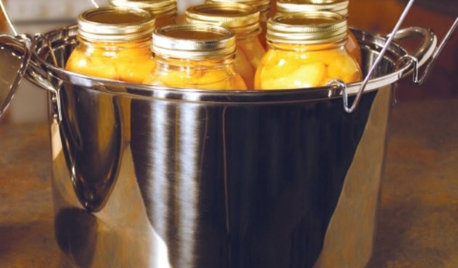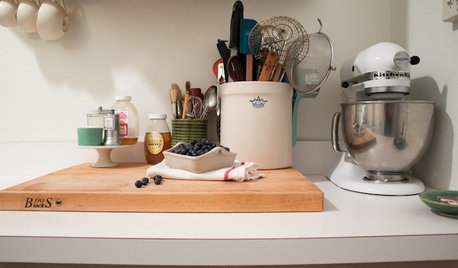Preserving sourdough starter?
John__ShowMe__USA
17 years ago
Related Stories

PRODUCT PICKSGuest Picks: Canning, Preserving, Steaming, Dehydrating
20 products to help make fall produce last through the season and beyond
Full Story
ORGANIZINGSimple Pleasures: Preserving Analog Memories in a Digital World
Too often our photos and mementos accumulate in computers and in piles. Here’s how to free them up to be displayed and enjoyed
Full Story
KITCHEN DESIGNKitchen of the Week: Tiny, Fruitful New York Kitchen
Desserts and preserves emerge from just a sliver of counterspace and a stove in this New York food blogger's creatively used kitchen
Full Story
TRADITIONAL HOMESHouzz Tour: Historic Charm Restored to a Dilapidated Coastal Home
Along the waterfront in Annapolis, Maryland, a couple gain space but preserve their 1800s home’s period looks
Full Story
SMALL SPACES10 Tips for Chic Little Bathrooms
Get more visual appeal and storage in less space, following the lead of these stylish compact bathrooms
Full Story
ARCHITECTURE5 Incredible Home Conversions
Born as a factory, a school, a warehouse and even a radiator shop, these spaces became unique homes for their forward-thinking owners
Full Story
TRADITIONAL HOMESHouzz Tour: Historic Manor House Regains Its Country Style
A neglected 11th-century property is restored to its former glory as a traditional family home
Full Story
HOUZZ TOURSHouzz Tour: New Tower Rises From a Midcentury Ranch House
An Austin homeowner and her architect expand on the original vision of A.D. Stenger, who designed the ’60s-era home
Full Story
REMODELING GUIDESConsidering a Fixer-Upper? 15 Questions to Ask First
Learn about the hidden costs and treasures of older homes to avoid budget surprises and accidentally tossing valuable features
Full Story
DECORATING GUIDESClean Start: Fresh-Faced White Planking
White-plank walls add simple style and enough texture to keep things interesting
Full Story


John__ShowMe__USAOriginal Author
John__ShowMe__USAOriginal Author
Related Discussions
Sourdough starter is a non-starter
Q
Is this old sourdough starter is still good to use?
Q
Experts herald Canadian woman's 120-year-old sourdough starter!
Q
Sourdough starter - Can we talk?
Q
annie1992
ksrogers
John__ShowMe__USAOriginal Author
annie1992
bejay9_10
annie1992
John__ShowMe__USAOriginal Author
ksrogers
annie1992
crrand
mellyofthesouth
ksrogers
annie1992
John__ShowMe__USAOriginal Author
ksrogers
bejay9_10
John__ShowMe__USAOriginal Author
ksrogers
bejay9_10
ksrogers
annie1992
ksrogers
jimster
ksrogers
annie1992
ksrogers
bejay9_10
annie1992
ksrogers
annie1992
ksrogers
annie1992
ksrogers
bejay9_10
jimster
bejay9_10
jimster
ksrogers
ksrogers
John__ShowMe__USAOriginal Author
ksrogers
ksrogers
larudett_hotmail_com
ksrogers
tania
ksrogers
bejay9_10
babciaherbata